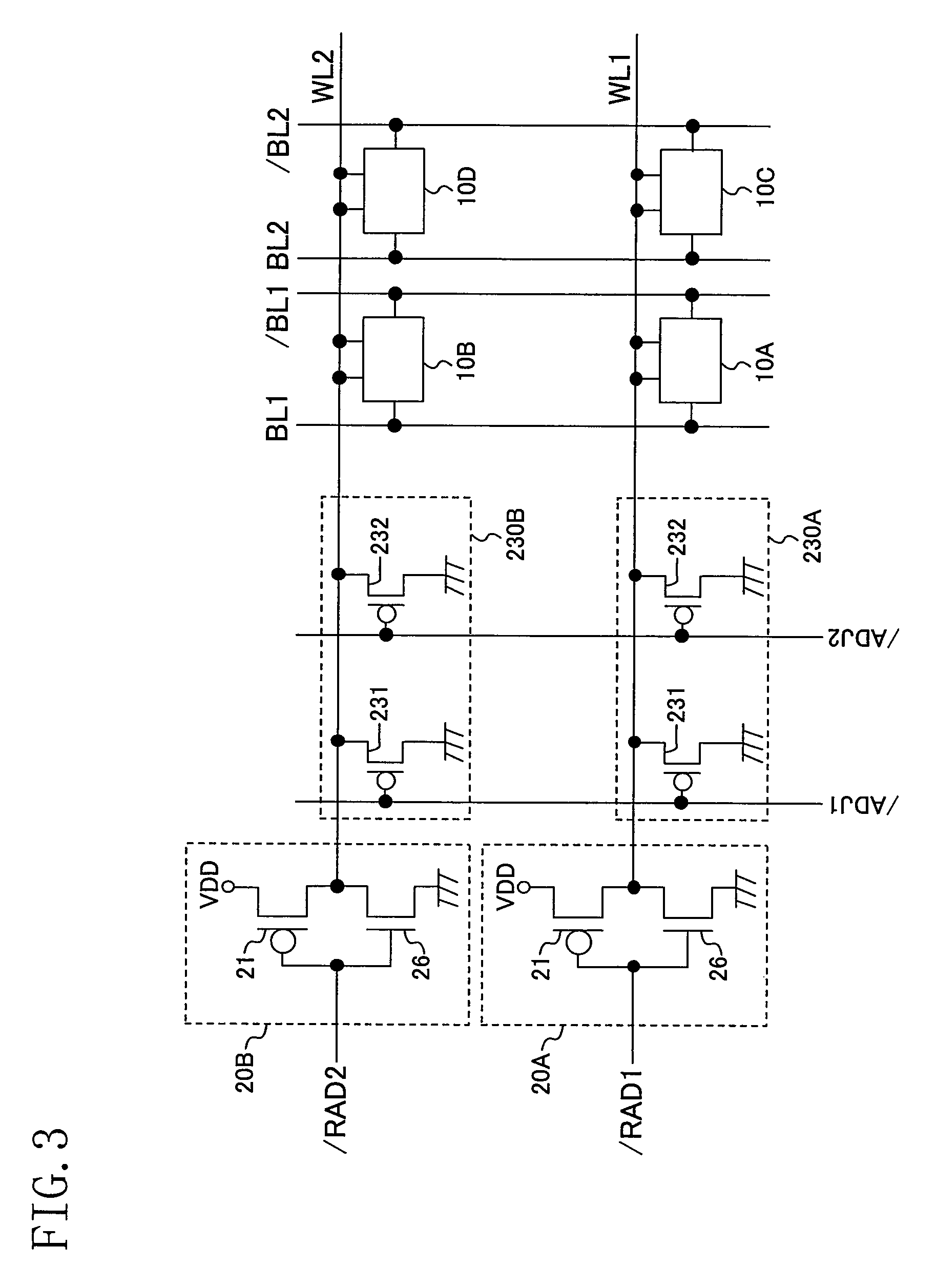Semiconductor integrated circuit
a technology of integrated circuits and semiconductors, applied in the direction of information storage, static storage, digital storage, etc., can solve the problems of inability to use the method described in patent document 1 and the inability to impart stable characteristics to memory cells, and achieve the optimization of the voltage of the active state of the word line, and the improvement of the static noise margin of the memory cell
- Summary
- Abstract
- Description
- Claims
- Application Information
AI Technical Summary
Benefits of technology
Problems solved by technology
Method used
Image
Examples
first embodiment
[0030]FIG. 1 is a block diagram showing a configuration of a semiconductor integrated circuit according to a first embodiment of the present invention. The semiconductor integrated circuit of FIG. 1 has memory cells 10A, 10B, 10C and 10D, word line drivers 20A and 20B, and pull-down circuits 30A and 30B.
[0031]The word line drivers 20A and 20B each have a PMOS transistor 21 and an NMOS transistor 26. The pull-down circuits 30A and 30B each have a PMOS transistor 31 as a pull-down transistor.
[0032]In the word line drivers 20A and 20B, the PMOS transistor 21 and the NMOS transistor 26 constitute an inverter. The word line drivers 20A and 20B invert row address signals / RAD1 and / RAD2 and output the results to the word lines WL1 and WL2, respectively.
[0033]In the pull-down circuits 30A and 30B, the source terminals of the PMOS transistors 31 are connected to the word lines WL1 and WL2, respectively. The gate terminal and the drain terminal of the PMOS transistor 31 are both connected to...
second embodiment
[0050]FIG. 3 is a block diagram showing a configuration of a semiconductor integrated circuit according to a second embodiment of the present invention. The semiconductor integrated circuit of FIG. 3 is similar to the semiconductor integrated circuit of FIG. 1, except that pull-down circuits 230A and 230B are provided instead of the pull-down circuits 30A and 30B. The other parts are indicated by the same reference symbols and will not be described.
[0051]The pull-down circuit 230A has PMOS transistors 231 and 232 as pull-down transistors. In the pull-down circuit 230A, the source terminals of the PMOS transistors 231 and 232 are connected to the word line WL1, and the drain terminals thereof are connected to the ground. Word line voltage adjustment signals / ADJ1 and / ADJ2 are given to the gate terminals of the PMOS transistors 231 and 232, respectively. The pull-down circuit 230B is similar to the pull-down circuit 230A, except that the pull-down circuit 230B is connected to the wor...
third embodiment
[0063]FIG. 4 is a block diagram showing a configuration of a semiconductor integrated circuit according to a third embodiment of the present invention. The semiconductor integrated circuit of FIG. 4 is similar to the semiconductor integrated circuit of FIG. 1, except that pull-down circuits 330A and 330B are provided instead of the pull-down circuits 30A and 30B and a pull-down control circuit 40 is further provided. The other parts are indicated by the same reference symbols and will not be described.
[0064]The pull-down circuits 330A and 330B each have a PMOS transistor 331 as a pull-down transistor. In the pull-down circuits 330A and 330B, the source terminals of the PMOS transistors 331 are connected to the word lines WL1 and WL2, respectively. A pull-down control signal / PD is given to the gate terminal of the PMOS transistor 331, and the drain terminal thereof is connected to the ground.
[0065]The pull-down control circuit 40 has PMOS transistors 41 and 42. The PMOS transistors ...
PUM
 Login to View More
Login to View More Abstract
Description
Claims
Application Information
 Login to View More
Login to View More - R&D
- Intellectual Property
- Life Sciences
- Materials
- Tech Scout
- Unparalleled Data Quality
- Higher Quality Content
- 60% Fewer Hallucinations
Browse by: Latest US Patents, China's latest patents, Technical Efficacy Thesaurus, Application Domain, Technology Topic, Popular Technical Reports.
© 2025 PatSnap. All rights reserved.Legal|Privacy policy|Modern Slavery Act Transparency Statement|Sitemap|About US| Contact US: help@patsnap.com



